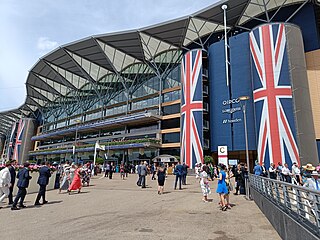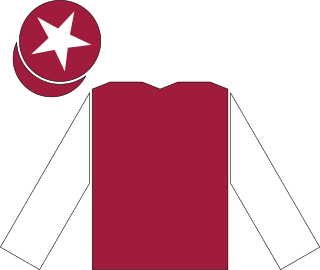Related Research Articles

Horse racing is the second largest spectator sport in Great Britain, and one of the longest established, with a history dating back many centuries. According to a report by the British Horseracing Authority it generates £3.39 billion total direct and indirect expenditure in the British economy, of which £1.05 billion is from core racing industry expenditure, and the major horse racing events such as Royal Ascot and Cheltenham Festival are important dates in the British and international sporting and society calendar.

The Jockey Club is the largest commercial horse racing organisation in the United Kingdom. It owns 15 of Britain's famous racecourses, including Aintree, Cheltenham, Epsom Downs and both the Rowley Mile and July Course in Newmarket, amongst other horse racing assets such as the National Stud, and the property and land management company, Jockey Club Estates. The registered charity Racing Welfare is also a company limited by guarantee with the Jockey Club being the sole member. As it is governed by Royal Charter, all profits it makes are reinvested back into the sport.

Ascot Racecourse is a dual-purpose British racecourse, located in Ascot, Berkshire, England, about 25 miles west of London. Ascot is used for thoroughbred horse racing, and it hosts 13 of Britain's 36 annual Flat Group 1 horse races and three Grade 1 Jumps races. The current racetrack's grandstand was completed in 2006.

Ghost Stations is a series of books by the British military historian Bruce Barrymore Halpenny, containing ostensibly true ghost and mystery stories generally connected to the RAF, airfields and other military or war connected stories.

Nottingham Racecourse is a thoroughbred horse racing venue located in Nottingham, Nottinghamshire, England. It is situated at Colwick Park, close to the River Trent and about 3 km east of the city centre.
Bruce Barrymore Halpenny was an English military historian and author, specializing in airfields and aircraft, as well as ghost stories and mysteries. He was also a broadcaster and games inventor.
Harry Thomson Jones, often known as "Tom Jones", was a British racehorse trainer whose career lasted from 1951 to 1996. He was successful in National Hunt racing, training the winners of 12 Cheltenham Festival races before switching to flat racing and going on to train the winners of British Classic Races.

Oh So Sharp (1982–2001) was an Irish-bred, British-trained Thoroughbred racehorse best known for winning the English Fillies' Triple Crown in 1985. In a racing career which lasted from August 1984 until September 1985, she won seven of her nine races, starting favourite on each occasion and never at odds of more than 2/1. She was one of the leading two-year-old fillies of 1984 when she was unbeaten in three races, including the Fillies' Mile. In the following year Oh So Sharp won the 1000 Guineas in record time and then took the Oaks by six lengths before being narrowly beaten in her next two starts in major weight-for-age races. The filly completed the Triple Crown in the St Leger Stakes. She was retired at the end of the season and became a successful broodmare. Oh So Sharp died in 2001 at the age of nineteen.
Baron Barrymore Halpenny is a commercial artist, executive editor, writer and historian of traditions and culture. Working for several publications, he is best known for his book cover illustrations for Ghost Stations for which he has also been editor for the newly released series; also known for writing 'Ways of the Wolf'.
British Racing and Racecourses (ISBN 978-0950139722) published in 1971 with a first print run of 10,000, was written by the female equestrian writer, Marion Rose Halpenny, and was the first book with general all round racecourse information, precise definitions of terms used to describe track surfaces, with plans of all racecourses that had broken completely new ground.
Landscape (1813–1834) was a British Thoroughbred racehorse and broodmare that won the classic Oaks Stakes at Epsom Downs Racecourse in 1816. The filly's entire racing career consisted of one run in 1815 followed by three races in the space of thirteen days in June 1816. After winning the Oaks on her second racecourse appearance, she finished first and second in races at Ascot. Already pregnant at the time of her classic success, Landscape was retired from racing after Ascot and produced her first foal in the following spring.
Arena Racing Company, also called ARC Racing and Leisure Group is a UK private company, created in 2012 by the merger of Arena Leisure and Northern Racing. It owns and operates 16 racecourses in Great Britain, accounting for 39% of British racing fixtures. It also operates hotels at Wolverhampton Racecourse, Lingfield Park Racecourse and Doncaster Racecourse and golf courses at Lingfield, Southwell and Newcastle. Following the purchase of Nottingham Greyhound Stadium in 2020 the company became the leading greyhound racing operator in the UK. In November 2022, it was announced Arena Racing Company had acquired the Athens-headquartered omni-channel content distributor, Vermantia.
Fairy Footsteps was a British Thoroughbred racehorse and broodmare best known for winning the classic 1000 Guineas in 1981. She showed promise in her first two races as a two-year-old before establishing herself as one of the best fillies of her generation with an emphatic win in the Waterford Candelabra Stakes. In the spring of 1981 she was heavily backed for the 1000 Guineas before and after a win in the Nell Gwyn Stakes. She won the 1000 Guineas by leading all the way and was considered highly likely to follow up with a win in the Epsom Oaks but was retired after a disappointing defeat in the Musidora Stakes. She had some success as a broodmare.
Picture Play (1941–1956) was a British Thoroughbred racehorse and broodmare, who raced during World War II and was best known for winning the classic 1000 Guineas in 1944. As a two-year-old she won twice from four races before winning the 1000 Guineas by four lengths on her three-year-old debut. She was injured in her only subsequent race and was retired to stud. She went on to become a very successful and influential broodmare, whose descendants have won seven classics and many other major races.

Sleeping Partner was a British-bred thoroughbred racehorse and broodmare. She showed modest form as a juvenile in 1968 but developed into a top class performer in the following year, winning the Lingfield Oaks Trial, Epsom Oaks and Ribblesdale Stakes. She did not win again and was retired from racing in 1970. She produced no known foals.

Pia was a British-bred Thoroughbred racehorse and broodmare. She showed top-class form as a juvenile in 1966 when she won three races including the Cherry Hinton Stakes and the Lowther Stakes as well as finishing second in the Cheveley Park Stakes. In the following year she ran fourth in the 1000 Guineas and third in the Musidora Stakes before recording her biggest win in the Epsom Oaks. Later that year she dead-heated for first place in the Park Hill Stakes and ran fourth in a strong renewal of the Champion Stakes before being retired from racing. Although her foals made little impact on the track, her daughter Principia became an influential broodmare.
Monade was a French Thoroughbred racehorse and broodmare. After showing great promise as a two-year-old in 1961 she reached her peak in the following year when she won the Prix Imprudence, Prix Penelope, Epsom Oaks and Prix Vermeille as well as finishing second in the Prix de l'Arc de Triomphe. She remained in training for two more seasons, winning the Prix de Pomone and the La Coupe de Maisons-Laffitte in 1963. After her retirement from racing she became a very successful broodmare.

Tranquil was a British Thoroughbred racehorse and broodmare. She showed considerable promise as a two-year-old when she won one race and finished second in the Gimcrack Stakes. In the following season she was one of the best horses in Britain, scoring classic victories in the 1000 Guineas and St Leger Stakes as well as winning four other races including the Jockey Club Cup and Newmarket Oaks. She won once in 1924 before her racing career was ended by injury. She made no impact as a broodmare.

Vedas was a British Thoroughbred racehorse. As a two-year-old in 1904 he was highly tried and won six of his ten races including the Brocklesby Stakes and Molecomb Stakes as well as being placed in the Coventry Stakes and Gimcrack Stakes. In the following spring he recorded his biggest win in the 2000 Guineas but was injured shortly afterwards and failed on his only subsequent start. He was reported to have died in early 1906.
Brocade was a British-trained Thoroughbred racehorse and broodmare. Unraced as a juvenile she began her racing career in 1984 and showed high class form to win the Oak Tree Stakes and the Challenge Stakes as well as finishing second in the Prix Quincey. After struggling to recapture her best form as a four-year-old she ended her racing career with a win in the Prix de la Forêt. She was highly successful as a broodmare, producing several winners including Barathea and Gossamer.
References
- ↑ Your Chance for some horse trading – Racing by Geoff Ford – Evening Telegraph – Tuesday, 29 January 1985
- 1 2 Leasing a Racehorse – Evening Post – Saturday, 2 February 1985
- ↑ Mum's the word for this lady racing expert Evening Telegraph – Tuesday, 16 March 1971
- 1 2 Racebook author from Lincoln makes it a double Lincolnshire Echo – Wednesday, 24 March 1971